PET SITTER’S

Safe Handling & Restraint
Transporting injured pets
Avoiding Bites & Scratches
Staying safe while pet sitting
Asking Clients for Testimonials to include on your website

+Damaged Door Frames
Addressing Destructive Cat Scratching

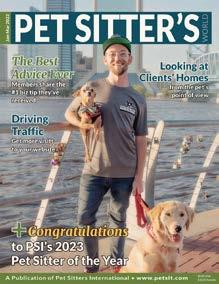

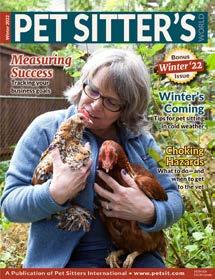



Transporting injured pets
Avoiding Bites & Scratches
Staying safe while pet sitting
Asking Clients for Testimonials to include on your website

Addressing Destructive Cat Scratching










While most PSI members we speak with stay pretty busy year-round, the summer vacation season always seems to be an extra busy time.
To get ready, you’ll of course need to check your schedule, see if you need to hire extra help and double-check reservations, but I also encourage you to get ready and be proactive about prioritizing your self-care and well-being.

As you prepare yourself for this particularly demanding time of year, these tips may help:
Set boundaries. Your necessary boundaries will be unique for you. For me, this involves putting limits on how “connected” I am. It’s easy to get in the habit of checking your phone 24/7, so I’ve implemented some personal rules—no checking email after a specific time in the evening and no work-related social media on the weekends (posts can be pre-scheduled!).
Simplify processes. Look at your regular tasks—whether that’s scheduling, posting on social media, invoicing, etc. Are there things you can automate to save time? Non-work tasks can be simplified as well (e.g., meal prepping, laying out your clothes the night before, etc.).
Soak in the sunshine. For me, being outdoors is such a stress reliever—hiking, walking my dogs, etc. Maybe you enjoy a massage, meeting up with friends, a spa day, etc.? Make time for the things you love! Remember, though, there aren’t enough bubble baths in the world to make up for bad boundaries (see tip #1!).
Do you have other tips for prioritizing your well-being this summer? I’d love to hear them! Send me an email at beth@petsit.com …but if you email over the weekend, I won’t be able to respond until Monday (boundaries!).

PSI President
Patti Moran, Publisher
Beth Stultz-Hairston, Editor
Michelle Boles, Layout and Design
ADVERTISING
PSI Advertising
P.O. Box 457, Pfafftown, NC 27040
advertising@petsit.com
HOW TO REACH US
P.O. Box 457
Pfafftown, NC 27040
Phone: (336) 983-9222, Press 1 for Member Services
Email: info@petsit.com
Website: www.petsit.com
OFFICE HOURS
Monday—Thursday, 9:30 a.m.—5:00 p.m., Eastern Time
STAFF
Patti Moran, Founder & CEO
Beth Stultz-Hairston, President
Debbie Leonard, Systems Operations Manager
Michelle Boles, Graphic Design Manager
Meghann Evans, Education & Outreach Manager
©Copyright 2023 by Pet Sitters International Inc. All rights reserved. Pet Sitter’s World is the official publication of Pet Sitters International, Inc. (PSI). Printed in the USA.
Pet Sitter’s World is published by PSI and is available exclusively through PSI membership. No portion of this publication may be reprinted or reproduced without the written consent of PSI and all authorized reproductions must cite Pet Sitter’s World, published by Pet Sitters International, as the source. Requests for reprint permission should be addressed to Editor, Pet Sitter’s World, P.O. Box 457 Pfafftown, NC 27040.
Publication of any article or advertisement should not be deemed an endorsement of the opinions expressed or products advertised. Pet Sitter’s World is a trademark of PSI.
Whether you’ve just joined PSI or are a long-time member, these resources will help you take full advantage of your PSI membership.






Information is right at your fingertips 24/7, 365 days a year in the Members Area of petsit.com. Log in to access:
• Free Monthly Member Toolkit
• Free custom business profile on PSI’s Pet Sitter Locator
• PSI member logos

• Customizable, downloadable pet-sitter forms

• Customizable, downloadable promotional materials
• Ready-to-use social-media images
Access the business tools you need—at special discounts—through PSI’s Preferred Providers:
• Pet-sitter liability insurance and bonding at a group rate
• Discounted background checks for you and staff
• Assistance with health and supplemental insurance
• Discounted digital products and courses available through PSI

As a member you can increase and demonstrate your knowledge as a pet-care business owner. Resources and opportunities include:
• Pet Sitter’s World magazine
• Free live and on-demand webinars
• The PSI Blog
• Discounted rates on PSI’s online courses
• Discounted rate on PETSIT PRO
• Opportunity to earn the Certified Professional Pet Sitter-CPPS® designation
PSI membership also offers strength in numbers. You can take advantage of a variety of opportunities to share your lessons learned and learn from fellow PSI members. Opportunities include:
• Professional Pet Sitters Chat, PSI’s private, members-only Facebook group
• Pet Sitter World, PSI’s annual in-person conference
• FOCUS, PSI’s one-day online summit for pet sitters and dog walkers
• PSI-Registered Networks
• PSI’s Facebook, Instagram and YouTube
Take the Pet Sitter’s World Quiz to earn renewal CEUs.
You can get a maximum of 10 CEUs per three-year renewal cycle with these quizzes. Look for a new one in each issue of Pet Sitter’s World!
If you are a CPPS, you can now earn one (1) CEU for answering all five of these questions correctly. The answers can all be found in the pages of this issue of Pet Sitter’s World.
Important: To submit your quiz answers, please visit petsit.com/ceu-request to fill out and submit PSI’s CEU Request Form. Quiz answers should be submitted through this form and not emailed directly to PSI.
1. According to the article in this issue, what are the two main goals of client testimonials?
2. True or False: Gently misting a cat with a spray bottle when they scratch doorposts or other inappropriate spots is a harmless way to redirect their behavior.
3. Fill in the blanks: The most applicable and common [general liability insurance] exclusion many pet sitters often aren’t aware of (until an incident arises!) is the exclusion for damages to your ______ ______.
4. Name one of the three overarching rules Denise Fleck says you should keep in mind when transporting a dog or cat.
5. Fill in the blank: According to the CDC, more than 4.5 million people are bitten by dogs each year and more than ______ receive medical attention for dog bites each year in the United States alone.
View the complete list of CPPS renewal CEU options. In the Members area of petsit.com, use the Certification Program drop-down link to Certification Renewal > Certification Renewal Options.

By Beth Stultz-Hairston, PSI President
From organizing local pet food drives and volunteering at your local animal shelter to donating a percentage of your revenue to local causes or sponsoring local school or sports teams, there are so many ways that your pet-sitting business can give back to your local community.
While your corporate social responsibility plan (i.e., the way in which your business operates to help society) will not include global charitable initiatives like companies such as Microsoft or Starbucks, your business can still make a big difference in your local community—and there are plenty of good reasons to give back.
Participating in charitable efforts can benefit your business in many ways:
1. It can impact your bottom line. A recent study shared that 70 percent of millennials said they spend more money with brands that support causes. Think millennials aren’t an important part of your target audience? Think again. While the misperception of millennials as flighty college-aged individuals somehow still persists, it’s simply not true. Millennials (currently ages 27-42 years old) represent the largest segment of pet owners for all pet types, according to the American Pet Products Association (APPA). The APPA also shared that this generation is “willing to pay more for quality products and services to improve the health and well-being of their pets.”
2. It highlights your connection to the local community. Your position as a local professional small-business owner is one of the qualities that makes your company stand out—and your involvement in charitable efforts can further highlight what an integral part of the community your business is. What’s more, participating in local charitable events or even picking a dedicated charity that your company sponsors allows you to meet more members of your community and introduces your business to them.
3. It can boost staff morale. If you use staff sitters, donating to a charitable cause can have another unexpected perk—boosting morale! Employees may feel more invested in a company that gives to causes that are close to their hearts, and it gives them the opportunity to be involved in the community as well. Also, your charitable efforts can even help with your staff recruitment efforts. Your philanthropic efforts can help you stand out from other employers in the area, which can be an advantage when you need to hire reliable help.
4. It’s the right thing to do. Never forget that your business wouldn’t exist without local pets that need care and the members of your local community who use and spread the word about your services. As a professional business, finding ways to give back and have a positive impact on your local community should be part of your overall business plan.
Below is a list of pet-related observances (and a few other interesting celebrations) you can highlight on your company’ social media pages this spring.
PSI’s Pet Sitter Safety Month™
National Pet Month
Chip Your Pet Month
Responsible Animal Guardian Month
• May 3: National Specially-Abled Pets Day
• May 7: Mayday for Mutts
• May 7-13: National Pet Week®; Be Kind to Animals Week®; National Small Business Week
• May 8: National Animal Disaster Preparedness Day
• May 13: National Dog Mom’s Day
• May 14: International Chihuahua Appreciation Day
• May 20: National Rescue Dog Day
• May 23: World Turtle Day

National Pet Preparedness Month
American Humane’s Adopt-A-Cat Month®
Adopt a Shelter Cat Month
National Foster a Pet Month
National Microchipping Month

• June 4: Hug Your Cat Day
• June 4-10: Pet Appreciation Week
• June 8: National Best Friends Day
• June 13: World Pet Memorial Day
• June 19-23: PSI’s Take Your Pet To Work Week®
• June 19: PSI’s Take Your Cat To Work Day®
• June 23: PSI’s Take Your Dog To Work Day®
• June 24: Cat World Domination Day
Don’t forget that PSI includes free social-media images for petrelated holidays that you can download to share in each PSI Monthly Member Toolkit.


While pet observances and holidays like the ones shared for May and June can make great social-media topics if you customize your posts for your business and to be useful to your audience, you’ll need more content ideas to keep your social-media calendar full.
Consider these ideas:
Photos and videos of pets in your care: Remember, you must ask permission before sharing photos or videos of client’s pets (asking for permission in your contract is a good idea) and always take extra precautions to ensure that your sharing doesn’t jeopardize your client’s privacy (e.g., your photos/videos don’t display the exterior of client’s homes, contents within clients’ homes or other items that could give clues to where the pet lives).
Your story: Sharing why you became a professional pet-care business owner can be a powerful way to help clients and potential clients connect with you and your business. You may share your story by video, or simply post a photo of yourself with a pet and explain why you chose this career path in the caption. Your “why” is often what makes your business unique, and followers will appreciate learning your story.
Helpful tips: Establish yourself as a pet-care resource and promote sharing of your content by posting your tricks of the trade. Do you have a quick tip for removing dog hair from your clothes, or a simple method for pilling a cat that always works? Share it! Your followers will appreciate your willingness to share your expertise and want to pass your tips along.


When you work with pets all day, sustaining a bite or a scratch from one of your furry clients is not out of the realm of possibility—but it’s definitely not desirable.
Even a pet with no history of aggression can display unexpected behavior in certain circumstances or when facing new people or pets, but there are some simple precautions you can take to help prevent bites, scratches, and attacks.
More than 4.5 million people are bitten by dogs each year and more than 800,000 receive medical attention for dog bites each year in the United States alone, the Centers for Disease Control and Prevention (CDC) reports.
As a business owner, you should have policies in place to help keep yourself, the pets in your care and others you encounter safe. The possible liability issues and financial implications that could result from a dog bite are also concerns.
So how can you avoid dog bites from occurring while you are pet sitting or dog walking? PSI offers a few tips:
1. Get information about the history of each dog. Be sure to include questions on your profile sheet that allow you to collect behavioral information about each dog during a meet and greet with potential clients. You need to know about any aggressive tendencies the dog has shown before, anything that stresses or freaks out the dog, and any other relevant information.
If a dog has a history of aggression, you need to know, and it is totally okay—in fact, advisable—to turn down an assignment if you do not feel comfortable with the pet.
2. Learn to speak dog. As a professional pet sitter, it’s important to take advantage of opportunities to learn more about animal behavior. A good understanding of dog body language can help keep you and the pets and people you encounter while interacting with clients’ dogs safe. In many cases, the ability to recognize and understand subtle signals dogs may send when anxious can help you prevent being bitten. Fear Free offers a program specifically for pet sitters to help equip them with a scientifically sound knowledge base in animal body language, behavior and training basics, enrichment, home life, travel, and administering medications. (PSI is not a partner or affiliate of Fear Free, but members can use promo code PSI20 for 20% off Fear Free’s program.) Other organizations such as Doggone Safe™ provide a variety of online resources regarding dog behavior, and pet sitters can also reach out to local animal behaviorists or their veterinarians for suggestions on additional resources.
3. Do not allow people to interact with a client’s dog. Many dog lovers think it is okay to pet any dog they encounter, but as a pet sitter, you should avoid such interactions from strangers. Anything could happen, and you do not want someone—yourself, your client’s dog, or another person or pet—to get hurt on your watch. It’s a good idea to avoid highly-populated areas whenever possible while walking a dog or change direction to avoid other people and pets headed their way. Other pet sitters have reported that simply saying “I am working this dog and he shouldn’t be approached at this time” is a good way to stop would-be unwanted “petters” in their tracks should they try to approach the dog you are walking.
4. Keep your canine client on a leash and stay alert. If you are walking your client’s dog or out in public with the dog, keep your canine client on a leash. Even where off-leash walking is permitted, it can be dangerous.
It is important to be alert at all times when out in public with a client’s dog and to not be distracted by your phone or loud music. It is possible that other dogs will be off leash, which can present a danger to not only the dog in your care, but you as a pet sitter. If you have a new dog-walking client in an area you aren’t familiar with, it is also a good idea to take time to survey the area you have available to walk the dog near the client’s home. Make sure your path won’t include highly congested areas, construction zones or dead-end or poorly-lit streets.
If a dog in your care bites another dog or person the financial implications can be devastating, particularly if you are not adequately insured.
While dog-bite claims can vary depending on the specific situation and jurisdiction, David Pearsall, vice president of Business Insurers of the Carolinas, says that data from the Insurance Information Institute shows the average dog bite claim in 2021 was $49,025, (2022 data has not been released at the time of this writing.) The average is typically higher in litigious states like New York, Florida and California.
David further shared that—looking at all associations they work with—2022 was by far their worst year ever in terms of dog-bite claims paid, and that some of this had to do with courts not being open during COVID (so prior cases were just being settled). In addition, with three big claims paying out over $200K, $300K and $500K respectively, the average paid dog-bite claim in 2022 was in excess of $100K.
If you are bitten by a dog, this can also be financially devastating to you as a professional pet sitter. If you sustain a serious bite and are unable to pet sit, your medical bills combined with your lost wages can quickly add up.
It’s extremely important that pet sitters understand that general liability insurance/pet-sitter liability insurance does not cover personal injury for you (or your staff sitters) and relying on business insurance in these types of situations is not an option. David Pearsall cautions pet sitters to not make this mistake.
He shared: “Another mistake I often encounter from newer sitters (and some more experienced ones as well) is having a false assumption that general liability insurance covers injuries they sustain while pet sitting, such as being bitten by a client’s dog. Unfortunately, (continued)
the only way to cover injuries you or your employees or independent contractors sustain while on the job is workers’ compensation insurance.”
As a professional pet sitter, it’s important to give thought to how you would handle a pet bite or attack. If you expect the client to pay any associated costs, you will need to make sure your state law(s) allow this and that this is clearly explained in your pet-sitting service contract.
The Pet Sitting Service Contract available on petsit.com gives pet sitters a couple of different options and examples of legal language to include, depending upon how they plan to handle these injuries. This decision is a very important one, and one that may be affected by state laws where a pet-sitting business is located. PSI advises pet sitters to consult with an attorney and insurance professional before making the decision.
Remember, if you are bitten by a dog, don’t take chances with your health. The seriousness of a dog bite often depends on a variety of factors, including if the skin is broken, if there is one or multiple bites, and if the dog is current on its rabies vaccination. After accessing the injury, contact your physician to determine if a doctor’s visit or trip to the emergency room or urgent care is warranted. If a bite does not puncture or break the skin, watching for signs of infection such as redness or swelling before seeking medical care may suffice, but always seek medical advice to be sure of the best course of action.
When pet sitting a feisty feline, you have to be on guard against cat bites and scratches. No one wants to suffer from Cat Scratch Fever or other infections.
A three-year study conducted by the Mayo Clinic found that middle-aged women are the most common cat-bite victims, and 1 in 3 patients bitten on the hand by a cat had to be hospitalized.
According to the CDC, a mild infection can occur around the cut or bite about 3-14 days after it occurs. The infected area may be red, appear swollen, and feel warm or painful. Initial
symptoms may also include fever, swollen lymph nodes, and headache, among other symptoms. If you display any of these symptoms after a cat bite or scratch (or after a cat licking your open wound), you should contact your doctor immediately.
So how do you prevent negative encounters with a cat client? Dr. Jane Brunt, executive director of the CATalyst Council, was quoted in a previous PSI blog post and explained that cats “are both predators and prey, and people are often perceived as the predator.”
Brunt said: “This could be especially important to cat sitters to understand and learn how to both read body language and approach cats on their own terms… Fear is the number one cause of feline aggression, so understanding that (and responding appropriately) will help those who wish to help cats. As you know, for many of us, it’s all about the cat!”
As when you pet sit dogs or other animals, you need to get accurate behavioral information about any cat you plan to cat sit. During the meet and greet, ask clients to describe the cat’s likes and dislikes, their behavior around strangers and animals, and any other relevant information. Observing how the cat acts around their owners and around you during a meet and greet is not enough to go on, as many cats will behave differently when their owners



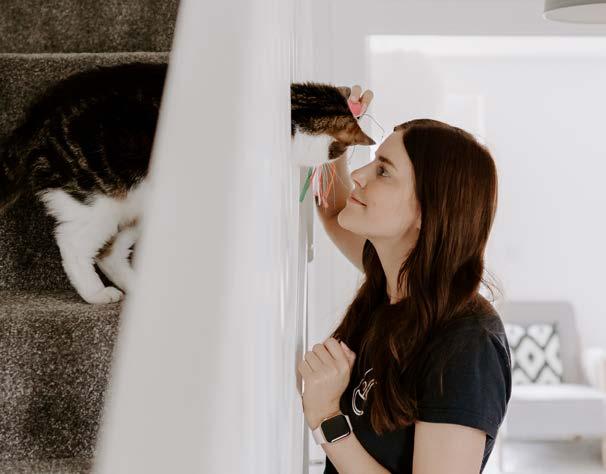
By Meghann Evans, PSI Education & Outreach Manager

When pet parents are looking for professional pet-sitting services in Stamford, UK, there’s a name that stands out—The Stamford Catsitter
From the strong online presence to the professional software and quality pet care, PSI member Lydia Haines’s company makes a positive impression on local pet parents.
Lydia began pet sitting in 2019 and has grown her company to 17 sitters ser-
vicing 650 clients, but this growth didn’t happen without work. She has spent late nights “liking” hundreds of photos from local Instagram accounts; she’s completed pet-care training and secured important business credentials. She’s also worked to find sitters to meet the growing demand.
“We are an all-female team and, although I didn’t set out deliberately not to hire men, it’s worked out this way and I’m really proud of that,” Lydia shares via email.

She continues: “We are all genuine animal lovers and each and every one of us will go the extra mile— whether that be staying longer at visits to get jobs done, sending detailed updates, popping back to the clients’ home to let the cat in who didn’t turn up at the visit previously, taking deliveries, hoovering or dealing with leaks, we will do it all for the client and their pets.”
And don’t let the business name fool you—while Lydia started out focusing on cats, she later expanded her company’s services to also include dogs, pocket pets, fish, birds, etc.—“any pets you may have in the home.” The Stamford Catsitter provides drop-in visits, overnights and live-in care, dog walks (solo and same household), wedding pet sitting and pet-taxi services.
Getting her start
Lydia always had a desire to work with animals but did not go down the veterinary route, so pet sitting was a great fit.
“Plus I used a cat sitter when I was living in London (I hadn’t known such a thing existed prior to this!) and absolutely loved receiving the updates and not having to worry
about the cattery,” Lydia shares. “I had a lightbulb moment and thought I could set up a similar business back in my hometown.”
Stamford is a charming historic market town of about 20,000 people, and Lydia’s company also services surrounding villages in a 25-mile radius, plus they recently expanded to cover Cambridge and its surrounding towns.
“Both Cambridge and Stamford are affluent places where the average person is more likely to spend a higher amount on their pets than in lots of other areas in the UK,” she explains.
Prior to her pet-sitting career, Lydia had secretarial and personal assistant posts in London, including a job with the government’s Ministry of Defence. The business skills she developed have proven “invaluable” to Lydia as an entrepreneur.
To get started, Lydia drew inspiration from the hundreds of pet-sitting websites and social-media pages she reviewed online. She also “undertook a Pet Sitting Diploma online, a Feline First Aid Course and got my DBS [background] check and insurance sorted.”

But she gained real-life experience from her initial meet and greets and pet-care visits.
“I’ve more or less learnt the tricks of the trade as I’ve gone along,” she says.
One of the business tips she learned sounds cliché, she says, but it’s this: “The client is always right.”
Tip for success: “If they [clients] have an issue, even if you know it wasn’t your/your sitters’ fault (within reason)— apologise to the max,” Lydia says. “That’s all they want! Offer to discount the service and say sorry 1,000 times. Then they will use you again and again no matter the issue. You don’t want anyone having anything bad to say about you or your customer service!”
While there are many group dog-walking companies and hobbyist Instagram pages in her area, Lydia says there aren’t any other professional pet-sitting businesses, so hers “definitely [has] the market share.”
Another thing that makes her business stand out is having cats at the forefront of their mission.
“Despite being a cat and dog lover in equal measures, I noticed a gap in the market in Stamford (an area absolutely saturated with dog walking and doggie daycare businesses) to provide a pet sitting service tailored to cats and small pets, with the additional bonus of photo updates and app functionality from Time To Pet,” Lydia writes. “I there-
fore struck out with very cat focused marketing (and obviously the business name!) and was very successful in growing a large kitty client base.”
Tip for success: Lydia provides this cat-care advice: “For cat sitters, don’t go to any visits without catnip spray, a string toy and a laser pen! They have helped me win over the most nervous of cats.”
Despite her initial focus on cats, Lydia soon realized that her bespoke service “worked perfectly for more nervous/older dogs and puppies too, for those that benefit from home visits and solo walks as opposed to group walking and kennel environments,” so she began advertising services for dogs, which quickly took off.
“Fast forward four years and now I think people just view ‘The Stamford Catsitter’ as a brand name, and we attract just as many dog clients as we do any other animal,” Lydia notes.
Lydia rolls out print media from time to time, like leaflets placed in local shops and on notice boards, and she has participated in a few business fairs, but she gains most of her clients through Instagram, Facebook and a low-budget Google ad that runs constantly.
“Social media is an extremely powerful and free tool that should be used more by small businesses,” she advises.
Lydia also recommends researching local pet fairs or business fairs, which “are great networking opportunities,” and emailing local newspapers and magazines to ask if they would be interested in featuring your local small business.
“It’s great to do this when you are expanding to cover a new town, or perhaps celebrating a milestone,” Lydia advises.

Utilizing technology
Lydia takes a modern approach to running her business, utilizing technology to her full advantage, and credits the Time To Pet software with a large amount of her company’s success. She explains that no other pet-sitting companies in her area use an app or portal, so The Stamford Catsitter has professional, easier functionality.
When it comes to marketing, Lydia says: “Instagram has been a particularly favourite tool of mine. I follow lots of local businesses on there (not just pet related) and ensure to like, comment and interact with the community all the time.”
Tip for success: Lydia has a top “trick of the trade” for Instagram. She will “head to the Geolocation page for ‘Stamford’ for example, scroll through photos/ videos uploaded and geotagged to that location and comment and like any that feature a cat/dog/ rabbit etc.”
In addition to “liking” photos from local accounts, Lydia has spent time reacting to Instagram stories from everyone her company follows, replying to them and making connections. She follows these practices with each new town her business services.
Tip for success: Lydia also advises pet sitters use Canva, an online graphic design tool, to its full potential “to give your social media pages a clear colour scheme and brand image.”
Consistent branding is a big focus for Lydia, who says: “A social media page full of pictures of cats and dogs is great, but doesn’t make you stand out from the crowd.”
“People have always commented on how great our social media pages and website look,” she continues, “and this is largely down to setting a clear colour scheme, font combination and general style that we stick to.”
The COVID-19 pandemic hit when Lydia was a solo sitter just eight months in, and she lost all of her bookings “pretty much overnight.”
“Luckily clients were super generous, buying gift vouchers and still paying for cancelled bookings etc., which really helped,” Lydia explains.
She also kept posting fresh content to her website and stayed active on social media—”playing petrelated challenges and games on our Instagram stories and getting everyone involved.”

All of these efforts kept interest in her business alive, and in the summer of 2020, she was so busy that she had to take on her first sitter.
To find quality sitters, Lydia advertises on Indeed.com and receives hundreds of applications, but she immediately discards those that don’t include a passionate cover letter. She also looks for candidates that have a “genuine care for animals and their well-being.”
Tip for success: When it comes to considering candidates, Lydia says: “Professional experience is a bonus, but my feeling is that the most important qualities of a pet sitter are honesty, integrity and a desire to go the extra mile for the animals (and clients).”
Lydia always meets candidates in person, going for a coffee to get to know them, and she trusts her gut, which rarely steers her wrong. She also requires all sitters to apply for a DBS check (criminal record check in the UK).
To retain quality sitters, Lydia organizes regular meet-ups for drinks, business birthday parties and Christmas parties. She is also a “big believer in treating them all with respect and kindness” and says if they make a mistake, she “will never be cross.”
“I genuinely care about them and I hope that they feel valued as a part of the team!” Lydia says.
Tip for success: Lydia’s team has a group WhatsApp chat for sharing knowledge, information and any questions sitters might have. Lydia says: “I’m always keen to stress to new sitters that the WhatsApp group is a safe space where there is no such thing as a silly question. Bonds have been made between all of the sitters through this, and to some extent it has become a pet loving community space more than anything.”
Planning for the future
Running a pet-sitting business is not without its challenges, like having pet-sitting and dog walking “viewed as a pocket-money type job, and therefore occasionally being talked down to.”
Then there are the clients who try to get around The Stamford Catsitter’s cancellation policy, refuse to use the company portal, or don’t understand the company’s size and assume they can make special accommodations or arrange meet and greets with little to no notice.
“I also find we get inundated with lots of messages from people asking if we know anyone who could rehome their pet, or if we know how to treat a particular illness/injury, or if we can recommend groomers, vets, etc.,” Lydia shares. “I feel the responsibility to personally respond to all of these enquiries, and they are sometimes
upsetting and weigh heavy on my heart.”
But running a professional pet-sitting business also comes with its joys. When asked what she loves most, Lydia says: “It has to be the freedom to manage my own schedule, working with a fantastic group of inspiring women, and getting to spend all day with furry friends rather than human beings.”
She also loves “the buzz of the busy seasons, Christmas, Summer, Easter etc., watching all the updates come through from the girls and just how many pets fall under our care at those times.”
Tip for success: Lydia shares this advice: “Don’t give up or lose hope in quiet periods. I have found the pet sitting business to be incredibly seasonal, and it can be really hard to stay enthusiastic throughout the slower months. Busier times are always right around the corner, though.” She recommends using the slower times to “catch up with admin, write blogs, review your service offerings and stay on top of your social media presence—coming up with creative ways to advertise your business for free (collaborations with other local businesses, giveaways, competitions, etc.).”
Lydia always says she is going to stop expanding her business, but she can’t see that happening. She would love to add on new service areas across England and eventually have an office space and administrative team.
“But even if none of that happens,” Lydia says, “I’d be thrilled to just keep going the way we are. It’s a dream already.”

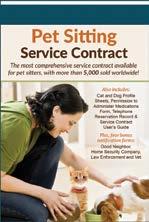
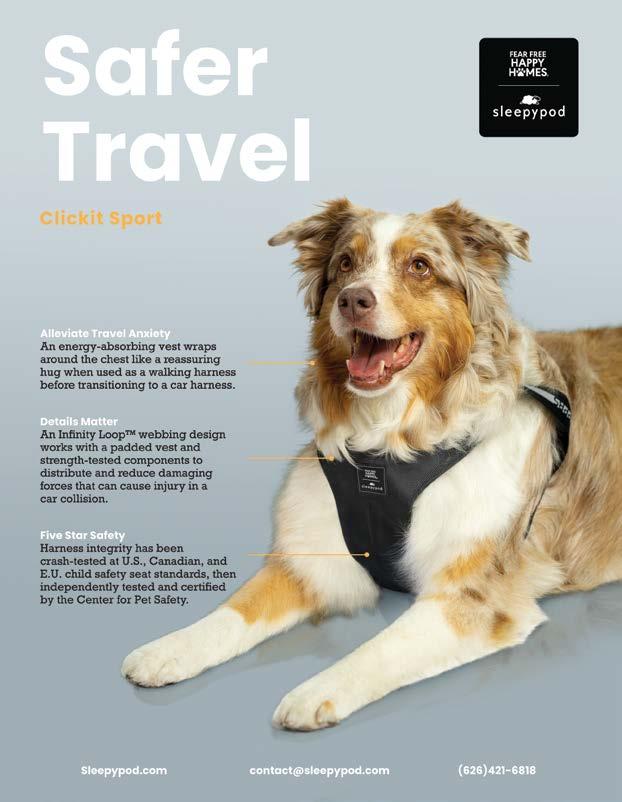
By Bobbi Wilson, CPPS©, Peace Love Paws Pet Sitters, LLC
Editor’s Note: While 85% of members responding to PSI’s 2022 State of the Industry Survey indicated they did not create a newsletter for clients, studies continue to show how important email marketing—such as emailing a newsletter to clients—can be for small businesses. In fact, according to a study from eMarketer, email marketing has a media return on investment (ROI) of 122%— four times higher than other digital marketing strategies. So, if you are in the majority who are not currently emailing your clients a newsletter, it may be time to reconsider! Thanks to Bobbi Wilson for sharing her tips for client newsletters!
Big or small, your pet-sitting company needs to be engaging with your pet parents! An effective form of visual communication is a newsletter. Business analysis recommends engaging with your client as much as once a week. Direct content is the “tool” for all engaging and attracting forms of communication. A newsletter allows you inexpensive, user-forward and personal visual communication for engaging with your pet parents. The choice of format, style, and delivery are endless, but it is about YOU and your brand.
A combination of a monthly newsletter and a bi-monthly newsletter catches a larger percentage of people with your information. One style of newsletter might be more attractive to some than others. Your monthly newsletter needs to be fun, engaging, pet informative and personal. Your bi-monthly news needs to be newsworthy!
Here are tips I’ve learned that help make our company newsletters a hit with our clients.
Be Consistent: You want your pet parents to look forward and be excited to see what information you have to share each month. Name your newsletters and use

consistent release days. For example, our newsletter is sent out on the 1st and is called The Monthly Chew. Our bi-monthly newsletter is sent out on the 15th and is called PLP’s Bi-Monthly News
Tip: Your newsletter should include your phone number, logo, email/ website information and QR code.
Be Engaging: The newsletter should speak to your pet parent, including informative pet facts, hot topics or a local event. Pet parents love to see their pets’ pictures. The bi-monthly newsletter should be more of a business informative important dates, company/staff awards and announcements.
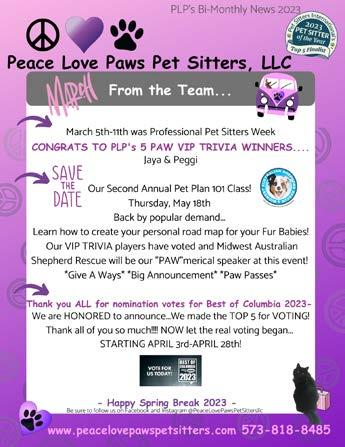
For example, in The Monthly Chew we include a personal message to our pet parents from us. Then, PLP’s Bi-Monthly News is our bulletin board to keep pet parents informed.
Tip: For more engagement, add a trivia question for a prize drawing!
Be Simple: Both newsletters need only three to four text sections each. The sections should be easy to read and short in content. Use lists and short paragraphs within your text sections. Be straight to the point, but informative. Use only a couple of pictures. Less is always better, and keep your sections defined with topic headers. The Monthly Chew has the same topic headers each month. PLP’s Bi-Monthly News template is always the same to keep it simple!
Tip: If you are not a “writer,” no worries! You can list your thoughts in simple bullet points to prove your point!

Bobbi Wilson is the co-owner of Peace Love Paws Pet Sitters, LLC, (along with her husband, Scott) in Columbia, MO. She earned her CPPS-Certified Professional Pet Sitter® designation through PSI in 2018 and was also named a top-5 finalist for PSI’s 2023 Pet Sitter of the Year™ award. Bobbi was a home inspector for 10 years and was the only female ASHI/AHIT certified home inspector in Missouri. She will also be presenting PSI’s June ’23 free member webinar, What You Need to Know about Home Safety as a Pro Pet Sitter
Be Creative: You are your brand, so do you! Most of us only meet our pet parents one time; this is a way to remind them why they chose you. Branding is not just a logo; it is the perception of you. Your colors, font, and topics are your visual communication. The Monthly Chew is pawsitively our branding and PLP’s Bi-Monthly News reflects our business delivery.
Tip: Abide by the three or fewer rule of different colors and/or font types.
Be Smart: Use the same information in your newsletters as you use for your social media. Not everyone follows all your postings, so duplication is expected. A cohesive topic makes it quicker for you to compile your information. For our business, The Monthly Chew highlights monthly social media topics, and then PLP’s Bi-Monthly News highlights factual content.
Tip: Invite new pet parents to subscribe to your newsletter through your social media and/or website.
Here’s what one client shared about my company’s newsletter: “I love that you include pet pictures, it shows your passion. You always include important information and always something new each month. I know I can count on your expertise—A real “go to” for knowledge. Super fun monthly themes…I look forward to each one and always open your email first” -D. Eagle, Columbia, MO
Consider putting these activities on your company’s to-do list for May and June.

May 1-5
It’s Pet Sitter Safety Month™! Be sure to view your Monthly Member Toolkit and visit petsit.com/safety to brush up on important safety tips for professional pet sitters and dog walkers. If you have staff sitters, share any relevant tips with them to ensure your company is following safe practices.
May 8-12
Will you need staff to help you manage your summer bookings? Don’t wait to publish your job posting online! Many pet sitters also find success sharing their job listings on social media or even reaching out to clients who could be interested in part-time work. If you are a solo sitter and your summer schedule

is filling up fast, let clients know they should book without delay.
May 15-19
PSI’s 2023 Pet Sitter World Educational Conference sold out quickly! If you signed up for the in-person conference, don’t forget to book your hotel room. If you would like to be put on a waiting list in case a registrant is unable to attend and wants to sell their ticket, please email info@ petsit.com. And stay tuned for details about a “session recordings only” option for pet sitters who can’t attend in person.
May 22-26
There’s just one month until PSI’s 25th annual
Take Your Dog To Work Day® to support pet adoption! Visit petsit. com/toolkit for ideas on how you can partner with local businesses to highlight the importance of pet adoption (and the importance of quality pet care for those pets!).
May 29-June 2
New social-media images are available for June and July pet-related holidays and observances, so visit Professional Pet Sitters


Chat this week to download them and also visit the Member’s area to view your Monthly Member Toolkit for June.

June 5-9
The busy summer pet-sitting season is underway! Make preventing burnout a priority this year. Review your weekly schedule to see if you have relaxing activities incorporated throughout, and if you have staff sitters, also talk to them about self-care. For resources, search “selfcare” at petsit.com.
June 12-16
Would you like to gain exposure in the industry and receive great prizes? Nominate yourself now for PSI’s 2024 Pet Sitter of the Year™ Award at petsit. com/pet-sitter-of-the-yearnominations. It’s the industry’s highest honor!
June 19-23
If temperatures are rising in your service area, consider

sharing pet safety tips on your social media pages, in your client newsletter and even in leave-behinds at clients’ homes. Visit www. petsit.com and search “hot weather” for important tips to “beat the heat.” Also remind any staff members to stay hydrated, protect themselves from the sun, and keep pets safe.

June 26-30

Your free social media images for July and August are now available in PSI’s private Facebook group. Also this month, go ahead and map out your marketing promotions for Q3 if you haven’t already. Take a look at your marketing efforts from Q2 to see how successful they were and if there are any tactics you would like to tweak.






By Mikaela Vargas, Pet Marketing Unleashed


Before we get into how to get testimonials, I have to ask: Do you have testimonials crammed together on one page of your website titled, ‘Reviews?’
If so, I have a challenge for you. Go to Google Analytics (or your website platform if they have analytics) and evaluate which pages have the most views. I highly doubt your review page is anywhere near the top. In fact, I bet it gets minimal views—if any! It’s taking up precious real estate, so it’s time to delete it.
Not to mention…The goal of your website is not for them to read through every page and testimonial. It’s to get them from point A (landing on your site) to point B (booking/taking the next step).
There are two main goals of testimonials:
1. To show social proof—i.e., you are credible, you have other happy clients, and you’re legit.
2. To put your potential client in the shoes of a transformed client, or what I like to call FOMO (Fear of Missing Out)—i.e.,“Wow, look at this pet parent who finally found someone who could care for their diabetic dog. I want that, too. I have to work with this company.”
Knowing this, here’s how to incorporate testimonials into your website:
• Organically place testimonials throughout your website, specifically on important pages like the home page, about page, new client page, and services pages.
• When applicable, have reviews that coordinate with the information on that page (i.e., have reviews about dog walking on the dog walking page and reviews about pet sitting on the pet sitting page; you can even have reviews about how easy it is to get started on your new client page!).
• Add testimonials to your blog posts when going over case studies or other relevant topics.
Tips on getting testimonials:
• You can let your booking software send a form after their service; however, I also recommend periodically sending a legit professional form (perhaps quarterly to those who haven’t filled it out yet).
• Don’t just ask, “Can you leave a review?” Ask them ACTUAL questions like… “What was your favorite or most memorable part of your experience? How did you feel using our software? How can we best support you in the future? Do you have suggestions on how we can improve?” These dialed-down testimonials can help you know where to place them on your website and demonstrate that you genuinely care about your clients’ experiences.
• If you want reviews on Yelp/Google My Business/ Facebook, don’t just ask them to go to Yelp and post a review. Provide them with the exact links within your email/form so it’s just a matter of pasting the one they already wrote (time-saver!).
• Ask them if they’d be willing to upload a picture of themselves and/or their pets to go with their testimonial. Testimonials with photos build extra trust!
• Ask permission to share their feedback on your website, social media, etc. A simple yes or no will do.
Here are some tips on editing testimonials (if necessary):
• You can fix grammatical errors/misspellings.
• You can bold or underline important words/phrases.
• You can shorten a testimonial (long ones often don’t get read). Just add “...” to fill in where you removed any text.
• You can change pronouns to your name/business name to clarify (i.e., from “she” to “Mikaela”)
• You cannot change the meaning of the testimonial or add/update words you think might sound better.
Testimonials are so valuable, especially for a personal industry like pet care. Whether it’s part of your software automation or you’re sending personal emails, make it part of your client process (create an email template to use time and time again). Soon enough, you’ll have amazing testimonials to showcase—building trust and credibility for many clients to come!

Mikaela Vargas is the founder of Pet Marketing Unleashed, a company focused on helping pet business owners (petpreneurs) build optimized and stress-free pet businesses through branding VIP Days, web design, website templates, and education. She is all about creating systems and strategies that reduce stress and get pet businesses working while away from your desk or out with the dogs! Learn more at petmarketingunleashed.com
By David Pearsall, Business Insurers of the Carolinas
Answering Pet Sitters’ “What If” Questions…
Question #2: Damage to your vehicle and personal property

As mentioned in my previous article in the Apr-Jun ’23 issue Pet Sitter’s World, for my next few articles I thought it would be helpful to provide answers to common insurance questions we receive on a weekly basis from professional pet sitters.
For this article, let’s focus on damages to the pet sitter’s vehicle or personal property caused by the clients’ pets while in your care, custody, or control. This applies to you (the owner of the pet-sitting business), as well as your employees and independent contractors that work on behalf of your business.
Unfortunately, we often do not receive this question until an incident has occurred, so the following is a very important read. This is especially important if you utilize employees or independent contractors, so that everyone on your team is made aware upfront of the answer to these property damage issues and questions.
Before we get to a couple of the specific scenarios/questions themselves, it is important to point out what the PSI liability insurance policy, (as well as most other pet sitter or dog walker general liability policies), actually cover.
To long time members out there, this may be obvious. However—believe it or not—I cannot tell you how many times we find members who do not know what is actually covered by their policy until an incident occurs. For the record, general liability insurance provides coverage/ protection against bodily injury or property damage claims arising out of your premises or operations or completed operations, in which you/ your business may be held legally

responsible for. This includes bodily injuries to a third party (e.g., if a client’s dog you are walking were to bite/injure a random stranger on a walk) or property damage (e.g., if a client’s dog were to get in a fight with a random stranger’s dog or cat while on a walk, at a dog park, etc., or if you or your team member were to break a vase or damage any of the contents in your client’s home).
All general liability policies come with specific exclusions that the insurance company will not provide coverage for. The most applicable exclusion for a pet-care professional is the exclusion for “Damage to Property” and specifically damage to “personal property in the care, custody or control” (i.e., your client’s pets and personal property/contents). Of course, most all pet-sitter liability policies offer an additional coverage endorsement or automatically include coverage for this particular exposure, as the PSI policy does.
However, there are several other exclusions under most all general liability policies that will apply to a pet sitter’s business, where no optional coverage or coverage endorsement is available. In some cases, these exclusions may be covered under another policy, and in other cases, there may be no option to cover at all.
The most applicable and common exclusion that many pet sitters often aren’t aware of (until an incident arises!) is the exclusion for damages to your personal property. This includes your vehicle (or your employee’s or IC’s vehicle), as well as your personal belongings or those belonging to your employees or ICs.
David Pearsall is the vice president of Business Insurers of the Carolinas (BIC) in Chapel Hill, North Carolina, which provides the Pet Sitters Liability Protection Policy and other insurance products to PSI members in the U.S. Visit www.psi-ins.com to learn more or contact BIC by phone at 1-800-962-4611.
To illustrate, let’s look at some routine claims calls/examples we often receive each month:
“Hey Laura, I have a situation with one of my sitters and think I need to turn in a claim. My employee was driving a new client’s dog to the park and evidently the dog chewed up the seat belt in the back seat. Am I covered for that?”
“Valerie, thank goodness you answered! Yes, I need to turn a claim in right away! My employee was at one of our client’s homes about an hour ago and she placed her cell phone on the kitchen counter while she was in the garage getting Sadie’s water bowl. She came back in and couldn’t find it. She said she searched around the kitchen where she remembered leaving it, and then all around the entire house and still couldn’t find it. Well, she finally found it. It was outside of the doggie door in the backyard. But it’s completed destroyed and Sadie obviously got ahold of it. Sally is devastated, so I need to get this turned in right away so she can get a new phone today! What do you need from me?”
“Hi Sherrie, I’d like to turn in a claim please. I was just at my client’s home to take care of their dog and had brought my own dog along for a play date. As soon as we walked in, the client’s dog just completely lost it. He attacked my dog, and unfortunately my baby got the worst of it. I’m at the vet now. Thank goodness they are saying he’s going to be okay, but they’re still running tests and stitching him up right now, so I need to turn this into my insurance, as my vet says it’s likely going to be close to $1,200, and I just don’t have that right now.”
“Hi Sharmen, I think I may need to report a claim. My contractor was in the process of putting the client’s dogs
in his car, and while he was placing the first one in the car, the other dog scratched up his car door pretty good. Does my insurance cover that?”
“Hi, is this David? David, this is Jennie, we met a long time ago at a PSI conference and I’ve been insured with you for almost four years now and never had a single claim…. Unfortunately it looks like my luck just ran out. I am boarding (in my home) two dogs for one of my clients this week while she is on vacation. I have taken care of these dogs so many times at their home and never had a problem like this, but I just got back from going to another client’s home, and they have chewed up and scratched up everything in my house, including my prescription glasses, my rug, the chair in my office, and both the doors leading in and out. Will my insurance cover all of this?”
Each and every one of these examples involve damage to the personal property or personal vehicles owned or leased by the pet-sitting business owner or their employee or independent contractor.
Unfortunately, as previously indicated, neither personal property (including your personal pets), nor personal vehicles—owned or leased by the insured pet sitting business owner(s)—nor any of their employees or ICs are covered under the PSI Liability Policy.
In the examples involving damage to a personal vehicle (whether your personal vehicle as the owner of the business, or your employee’s or IC’s personal vehicle), there may possibly be some coverage under the personal auto policy that is insuring the vehicle that incurs the damage, if physical damage coverage was included under the policy, and no exclusions exist. However, you would need to check with your personal auto insurance company or agent to be certain.
As for your personal property—to my knowledge—there will be no coverage under your homeowner’s or renter’s policy, as most all will have an exclusion for damage caused by animals and/or an exclusion for business use (if you were boarding in your home), but here again I recommend you contact your personal agent or insurance company to confirm.
• A pet sitter fed raisins to a dog she was pet sitting. The dog became sick and was taken to the vet. Total Paid $1,071.
• An employee knocked over a table in the client’s home. The table punctured a hole in the hardwood floor. Total Paid $1,355.
• A pet sitter failed to add dates of visits to their calendar and neglected to show up to take care of the client’s pet. The pet was left alone with no care for over a week. Total Paid $1,515.
• During a walk, the dog jerked away from the pet sitter to chase a cat. When the sitter was able to retrieve the dog, it had suffered an injury to their back leg. Total Paid $9,224.
• A dog was given too much food by pet sitter, resulting in a blockage in its stomach. Total Paid $2,501.
• Two dogs staying with the pet sitter got into an altercation and one was injured by the other. Total Paid $1,654.
• A pet sitter was entering the lobby of an apartment building with the client’s dog. The dog pulled backward from the pet sitter and his tail got caught in the door. Part of the dog’s tail had to be removed. Total Paid $3,070.
• During a walk with the pet sitter, the dog got out of their harness and attacked a smaller dog being walked by their owner. The client’s dog bit the person causing multiple bodily injuries. Total Paid $333,252.
• A client’s dog was staying at the pet sitter’s home. The dog went under the pet sitter’s deck and injured their neck. The dog required surgery. Total Paid $10,000.*
• A pet sitter left faucets dripping in the client’s home. Water overflowed causing damage to counter area, drawers, bathroom closet, and carpeting. Total Paid $11,045.
• *$10,000 was the Care, Custody, or Control limit purchased by the pet sitter, which unfortunately did not fully cover the vet expenses.
• An employee was in the process of letting a dog out and their finger became caught in the collar causing injury. Total Paid (medical only) $761.
• While attempting to open a window in a client’s home the employee suffered an injury to their arm. Total Paid (medical and indemnity) $3,119.
• While walking two dogs, an employee was pulled to the ground resulting in a fracture to their right clavicle. Total Paid (medical and indemnity) $4,939.
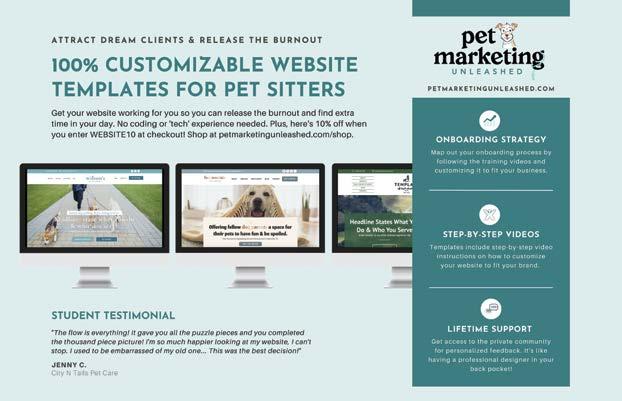





Did you know that, as a PSI member, you get access to both live and on-demand FREE member webinars each year? Additionally, if you are a CPPS-Certified Professional Pet Sitter® you can earn up to 2 CEUs per webinar (whether you watch live or view the recording).

You can currently access more than 10 on-demand webinars in the Members Area of petsit.com and take advantage of more live webinars coming up this year.
to register for upcoming webinars. Webinars are free to members, but preregistration is required. All member webinars are recorded for on-demand viewing, and the on-demand recordings of PSI’s webinars include closed-captioning and/or transcripts.
(now on-demand)
April 12 • 3 p.m. ET
Presenter: Doug Keeling, Bad to the Bone Pet Care
Running a busi ness without a plan would be like going on a road trip without a map, so why do so many pet sitters overlook this crucial step? In this session, Doug Keeling, owner of Bad to the Bone Pet Care and PSI’s 2023 Pet Sitter of the Year, will walk you through how to write a business plan guaranteed to help your business succeed!
In Case You Missed It…


June 14 • 3 p.m. ET
Presenter: Bobbi Wilson, CPPS®, Peace Love Paws Pet Sitters, LLC
During this PSI member webinar, Bobbi Wilson—professional petsitting business owner and retired ASHI/AHIT Certified Professional Home Inspector—will walk through a condensed, but precise, checklist of “must know” items to help a pet sitter be prepared for anything they may encounter in the client’s home on a pet-sitting visit.
In this session which will focus on the safety of the home and the pet sitter, Bobbi will explain how to find the locations of need-to-know components of the home, share how and when to collect information regarding the home, and provide tips to help you know when to call in a third party. She’ll also suggest gadgets to have on hand to help you determine safety issues.
The on-demand recording for February’s free member webinar is now available in the Members Area of petsit.com.
How to Set up a Social Media Marketing Program That Fits Your Target Market and Your Schedule
Presenter: Mychelle Garrigan, Pet Pro Marketing
Social media can seem overwhelming to the small businessperson. You know you need to get your business out there and start posting, but how do you start? Where should you post, and how often? This webinar will walk you through how to create a social media marketing plan that speaks to your target market and fits into your busy schedule with a minimum of stress!

PSI’s 2023 free member webinar series is sponsored by Business Insurers of the Carolinas, www.psi-ins.com.

By Doug Keeling, Owner & Founder of Bad to the Bone Pet Care
Have you dreamed of walking dogs on the beaches of Hawaii? Or have you formed an incredible bond with a pup that is moving far away, and you’d love to go care for them in their new town?
I didn’t think traveling as a professional pet sitter was possible when I started my business almost a decade ago, but I now have clients that not only pay my daily rate, but pay for all my travel expenses in several states and in Europe! Becoming a traveling pet sitter comes down to two things: networking and offering a premium service.


Sharing My Love of Travel with Clients and Other Pet Pros
In 2018, after several years of building a solid foundation for my business, I started telling all of our clients in our primary service area that I’d love to travel more. I’ll never forget rolling around on the floor with three labs as I talked to their “pawrent” about our lives and our goals. When I told her about my passion for traveling, she immediately said she had a sister across the country that was desperate for a good pet sitter. Within weeks, I was on a plane heading to Oregon for my first traveling pet-sitting gig.
After that first gig, I decided to make sure all of my clients knew not only about my love for animals, but my love for traveling also. Over the last few
years, I have had several clients with friends and family in amazing locations fly me out to help with their pets. I also dedicate time every month to build and foster relationships with other pet-sitting and dog-walking businesses in the areas I would love to travel to. We all know the importance of networking with local businesses, but there is a lot to be said for networking with businesses that aren’t local to us as well! I have gotten many great traveling clients by simply calling pet sitters and telling them I’d love to fly out and help with their clients if they ever get a live-in request that they can’t accommodate.
One of my absolute favorite things about the pet care industry has always been the sense of community over





Doug Keeling is the owner and founder of the award-winning Bad to the Bone Pet Care, and PSI’s 2023 Pet Sitter of the Year. Doug began pet sitting professionally in 2013 and has since grown a team of pet professionals servicing Northeast and Central Florida. Doug is also a traveling pet sitter offering his services across the country. Follow Doug on Instagram @DougtheDogGuyOfficial and his YouTube channel @DougtheDogGuy
competition. There will always be more families that need help with their pets than there will ever be pet sitters, and putting forth the effort to build relationships with other businesses in and out of your service area can be an absolute game changer. When I am looking for businesses to network with—in a place I would like to travel to—I always contact the most premium looking businesses first, as they will be the most likely to have the type of clients that can pay for a traveling pet sitter.
Offering and Promoting a Premium Service
I know what you’re thinking right now, “Why would someone pay to fly a pet sitter across the country instead of finding someone locally?” The price of a plane ticket and rental car may be overwhelming to a lot of us pet sitters, but that extra cost is trivial when you corner your services as a true premium offering and start working with high end clientele. The type of client that is willing and able to pay for this kind of service is not your average Joe. In my experience, they are almost always multi-millionaires that will stop at nothing to make sure their pets have nothing but the best. Getting these clients is easier said than done, but if I can do it, anyone can! I could talk all day about the benefits of working with higher-end clientele, but in the context of becoming a traveling pet sitter it
comes down to one simple fact: rich people know other rich people, and they trust each other’s recommendations.
Take some time to think about how and where you market your business. Chances are, you’re marketing in a way that attracts people similar to yourself and not marketing in a way that attracts the most affluent people in your community. This was certainly the case for me, and I honestly don’t think I would be able to attract clients willing to pay for my travel on top of my daily rate if I was still presenting my business in that way. Next, take a look at your services and how they compare to other pet sitters and dog walkers. What can you do to differentiate your services and really take things to the next level?
Enjoying a Dream Come True with the Support of My Team
Becoming a traveling pet sitter also would not have been possible without my amazing team being able to accommodate all our clients in our primary service area while I am on the road. If you are a solo sitter and don’t want to hire, another option would be to partner with other local sitters so they can fill in for you while you’re gone. There are pros and cons to both options, but either way you will need to make sure you aren’t leaving your existing clients without help if you are going to take your services on the road.
Being able to travel as a pet sitter is the ultimate dream come true for me. I have to pinch myself to make sure I’m not dreaming every time I head to the airport for another traveling gig. More than anything, doing these traveling pet-sitting gigs has shown me just how beautiful and helpful the pet-sitting and dog-walking community is. Even if you aren’t interested in becoming a traveling pet sitter, let this be your sign to network and build relationships with other pet businesses! If you’ve been thinking about becoming a traveling pet sitter, remember this: If I can do it, so can you!

How can you operate a more sustainable, eco-friendly pet-care business?
By Beth Stultz-Hairston, PSI President
Editor’s Note: This article was originally published in 2021, but it’s one we thought was worth resharing. Incorporating more eco-friendly practices into your business can benefit the environment, streamline your business processes and be a great selling point that you can highlight to eco-conscious current and potential clients!
In a 2019 survey conducted by the Pet Sustainability Coalition and World Pet Association, 91 percent of pet industry professionals reported that they expect the demand for companies that are environmentally friendly and socially conscious to increase.
So, how can you have a more sustainable, eco-friendly pet-sitting or dog-walking business?
First, let’s look at a couple of definitions: “Sustainability” refers to the “quality of not being harmful to the environment or depleting natural resources” (Dictionary.com). Similarly, “eco-friendly” is defined as “not environmentally harmful” (MerriamWebster).
As you build and grow your pet-care business, what are some policies and procedures you can implement to reduce your harm on the environment?
Say goodbye to paper
One of the most obvious is going paperless. Jennifer Jones, owner of Furry Friends & Co. in North Vancouver, BC, Canada, shared that she went paperless several years ago. When PSI asked members about going paperless in a 2020 poll, Jennifer explained, “All invoices are sent via email. We accept credit cards and e-transfer [no cheques anymore].” Instead of leaving paper notes after visits, she uses her online software system or text messages to communicate with clients.
While we’ve heard from many businesses who have been paperless for many years, the COVID pandemic seemed to have resulted in even more businesses moving in that direction. Janet Reed, owner of Dr. J’s Pet Services, LLC, in Austin, Texas, decided to go paperless for her client welcome packets due to COVID-19 and has found it has been a win-win. “Clients seem okay with it, and it has made my business life easier!” she shared.
I followed up with Janet this year to see if she had kept the above changes that she originally implemented because of COVID—and she had! She’s also now using Time To Pet, which she said is making her client management easy, and she sends a monthly client e-newsletter. Other than offering a paper or magnetic business card, Janet reports that everything else is digital!
In addition to being more eco-friendly and easier than printing and leaving behind paper invoices or notes, going paperless also has financial perks, Kaytlynn D’Agostino, owner of Kaytlynn’s K-9 and Cat Care in Delanco, New Jersey, recently discovered.
“I just switched to paperless and I don’t know why I didn’t do it sooner!” she said. “It cuts down on so much paper and the costs for my business that I was spending on ink. Clients also love the new professional look I’ve given my invoices—they couldn’t be happier.”
Look for eco-friendly pet products
Another way to operate a more sustainable pet-care business is to seek out environmentally-friendly options for the products you regularly use in your business, such as poop bags.
Jessica Milam, co-owner of Fur Services Fur Pets in Savannah, Texas, recommends GreenLine Pet Supply poop bags. She shared that these poop bags “have been verified independently to biodegrade in landfills” and that the company’s owner is “fantastic and highly supportive of the pet industry,” even offering a wholesale option for pet sitters.
You can also look for more environmentally-friendly versions of other pet products you and your clients use. Lisa Manfredi, owner of Kitty Koncierge, LLC, in North Haven, Connecticut, shared that she recom-
mends Cat Spot litter to her clients with a yard “because it’s 100 percent organic coconut which absorbs 500 percent and can be tossed in the lawn or into a garden bed to compost once spent.”
Melodi Landi, owner of Furry Fellas Pet Service LLC in West Warwick, Rhode Island, also promotes and offers eco-friendly pet products to her clients through an online shop on her company’s website. She says she focuses on offering pet products that are cruelty free (not tested on animals) and made primarily from natural and sustainable ingredients made in the United States.
Reduce your company’s carbon footprint
In addition to the ideas shared above, there are a variety of other ways you can reduce the carbon footprint of your company (and yourself). Do an energy audit of your home office (and home in general) and implement energy-efficient measures, including changing to LED light bulbs and switching off lights and unplugging your electronic devices when you aren’t using them. If you are shopping for a new vehicle, you may consider purchasing an electric or hybrid vehicle. And, you can cut down on your driving time by sticking to a reasonable service area and planning your pet-sitting visits to take the most efficient route.
Looking for more ideas to make your business more sustainable? Your employees (if you use staff) can be a great resource! Ask them about their eco-friendly practices and other pet-related sustainable businesses they support. You can also seek out recommendations from fellow pet-care professionals in your local pet-sitter network or in PSI’s private Facebook group, Professional Pet Sitters Chat
Make time this spring to “tidy up” your pet-sitting or dog-walking business. This will help set you up for success this summer and throughout the year.
Tip: Check each item off the list as you complete it. It may help to schedule a few tasks per week on your calendar or add a few to your weekly to-do list. You don’t have to try to complete everything at once!
Review your website. Make sure your contact information and service details are up to date, your photos and logos are consistent with your current branding, and there are no typos.
Review your social-media pages. Make sure you are using your latest company logo, and see if your bios or “about” sections need to be updated.
Organize your workspace. File any stray papers, remove unnecessary clutter, and donate any unneeded furniture or supplies to a thrift store or other non-profit.
Organize your computer. If you don’t have a digital filing system, create one, and file away the items cluttering your computer desktop. Also delete unnecessary emails and organize your inbox.
Get your books in order. Review your business accounts and sort through any receipts that need to be filed. Schedule an accounting software demo or a call with a local bookkeeper if needed.
Update your marketing plan. Summer will be here soon, so review past marketing strategies and map out your plans for 2023, including social-media ads and content.
Revise your business plan. With all that has changed in the past few years, take time to review your business plan and make sure it still reflects your vision, services and financial goals.
Do a supplies inventory. Check your business and pet-sitting supplies to make sure you have everything you need for the summer and restock as necessary.
Update passwords. If you haven’t updated your passwords in a while, now is a great time to do so. Also consider reviewing password management options online.
Create a self-care plan. Make a list of regular self-care activities you would like to add to your calendar, then schedule them like you would a pet-sitting visit.
Review your policies and procedures. You may have adopted new procedures in recent months, so review what’s working and what needs to change and document everything on paper—and be sure you’ve notified clients of any changes!
Review your staffing needs. Determine your anticipated business for the summer and how many staff sitters (if any) you will need, then begin the hiring process
Plan your vacation. Go ahead and decide when you would like to take vacation(s) later this year, add them to your calendar, and notify your clients and/or staff (if applicable).

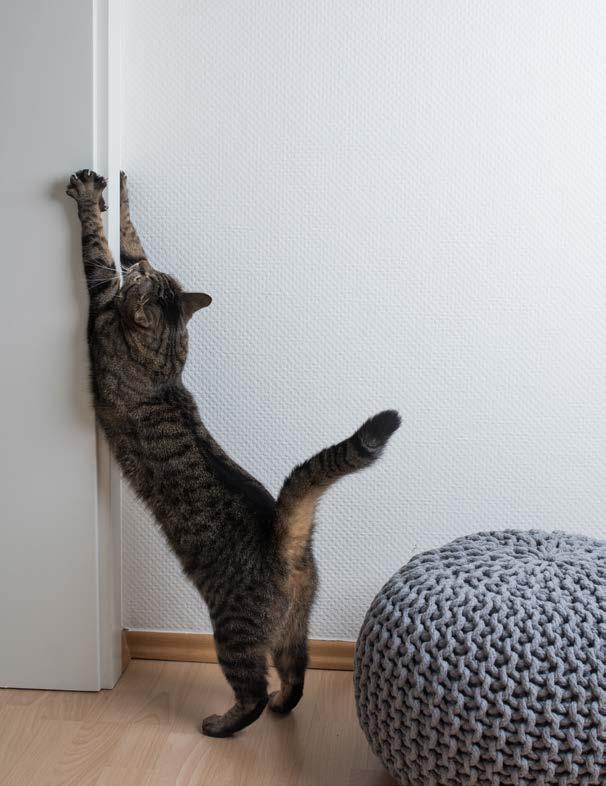
By Dr. Lynn Bahr, Dezi & Roo
Oh, how I would love to tell you there is a simple one-step solution to stop your cat from digging their claws into the door frames of your beloved home. But you know as well as I do that cat behavior is more complicated than that.
While most cat owners aren’t thrilled to see little scratch marks emerging all around our home, the reality is when you let an animal into your domicile there are going to be some pesky (and sometimes destructive) habits that pop up.
But you can take a few steps to redirect unwanted scratching—on furniture, door frames, or anything else you don’t want destroyed. The most important thing to remember is cats will not respond to physical punishment but can learn through strategic behavior redirection.
Why Is Your Cat Scratching Your Door Frames?
Cats need to scratch. Plain and simple. They have a natural instinct to claw at things. Cats scratch for a myriad of reasons: to decompress, to clean dead skin from their nail beds, to mark their territory, and to communicate. It’s not due to behavioral issues.



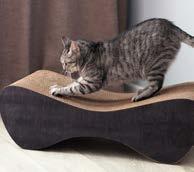
So why are they scratching up your door frames, or in some cases carpets and couches? The short answer: because it feels pawsome, and these surfaces are in the purrfect location for cats to announce themselves or leave messages. If you want your cat to communicate in the right way, you need to understand why cats scratch a particular item. Insider insight: it all boils down to placement and texture.
Placement: When cats walk into a room or patrol their territory, they announce themselves several times by scratching on surfaces along the way. This also allows them to leave messages—think of scratching like texting for cats.
Scratching surfaces located at entrances/exits or in plain sight makes sense. That’s why the corner of a couch or doorframe is so appealing. But it’s not just the location. In this case, height matters too.
Door frames, couches, and chairs are also sturdy and allow cats the ability to stretch and leave high visual marks. Cats stretch for physical relief (just like we do), but they’re also showing off muscle to possible invaders (kittens scratch low, adult cats scratch high).
Texture: Odds are, your cat is scratching your stuff because they don’t have enough scratch-worthy surfaces available to them. They need something that mimics the texture of the furniture and surfaces they like to scratch.
The purrfect scratching surfaces are cardboard, sisal, wood, cork, and sometimes paper or carpeting. Try offering a few different kinds of scratchers around your home and at varying heights and textures.
Outdoor cats use fence posts, tree stumps, railroad ties, fallen limbs, and the like. Indoor domestic cats need variety in texture and placement. This means the more suitable options, the better!
Bottom line, the most effective way to redirect Mr. Butternut Squash’s behavior is to offer him something even better—more advantageous locations or textures. And remember, cats can get bored of scratching the same things over and over. Variety is the spice of life as they say.
If you’ve had the same scratching post for a while, try rewrapping the post with fresh rope and sprinkle on some silvervine to pique their interest. If you don’t already own a post, try making a DIY cat scratching post
It can be so tempting to reach for that spray bottle when you see your cat ripping up your doors. While it seems harmless enough, punishment is not a good solution to the problem.
Relying on physical or verbal punishment to break your cat’s unwanted habits will strain their relationship with you. When you reach for that spray bottle or shout at your cat while they’re scratching a door frame it confuses them. They don’t know what they’ve done to receive this punishment, after all it is natural for them to scratch.
Cats are intelligent, and they are able to recognize the hand holding the bottle as the source of their discomfort. This will create a dynamic of fear between you and your feline, without actually teaching them anything. (continued)

Another mistake made by some cat parents is the decision to declaw their cats to stop the scratching. There are many reasons not to declaw your cat, including increased pain and lower quality of life. Declawing—or call it what it is, amputation—takes away your cat’s ability to grip onto toys at play time, their ability to stabilize on perches, and much more. Your cat’s claws are their most important tool
Take a No-Yes Approach to Redirecting Behaviors
Since cats won’t respond to physical punishments, the best way to change your furry companion’s destructive habits is to use a no-yes approach to behavior redirection.
Take note of the areas they are scratching and place a scratching post, cat tree, or play rug in that same spot. Additionally, find a good protective measure for the area, such as training tape (aka double-sided tape).
These protectors result in the surface becoming unsatisfying or discomforting for the cat to scratch. Then place cat scratchers and mats in that area to give your cat an alternative scratching option. By executing this approach, your cat will understand, “No, don’t scratch the door frame. Yes, do scratch this post.”


If your cat scratches up your door frames, try providing a vertical sisal scratcher which can mimic that upright scratching behavior.
If your cat has tendencies to attack the carpet, try getting a play mat which they can rip up to their heart’s desire. If they lean towards ripping up your couch, find a more plush vertical scratcher, like one wrapped in carpet, to satisfy your cat’s needs.
Training a cat isn’t easy. There is no timeline or blanket solution to getting your cat to stop scratching up your home. It is in their nature to claw at things.
The no-yes approach is great for redirecting these destructive behaviors, however, what works for one cat may not work for every cat. For this reason, you may need to go through trial and error to discover what works for your pet.
The time and effort is worth it to make sure you’re providing your fur baby the most enriching environment possible to keep them happy and whole.
If you try out the no-yes approach, snap a picture of your cat tearing into their new playmat or scratching up their post and share it with @DeziandRoo on Instagram.
Dr. Lynn Bahr is a 1991 graduate from the University of Georgia, College of Veterinary Medicine. Helping to strengthen the human-animal bond is her life’s mission and guiding force and her areas of interest and special care for felines include health and wellness, environmental enrichment, hospice, and ending the practice of declawing. Dr. Bahr is currently the CEO of Dezi & Roo, a company that designs, manufactures, and sells enrichment products that enhance the lives of cats and their owners. Learn more at deziroo.com





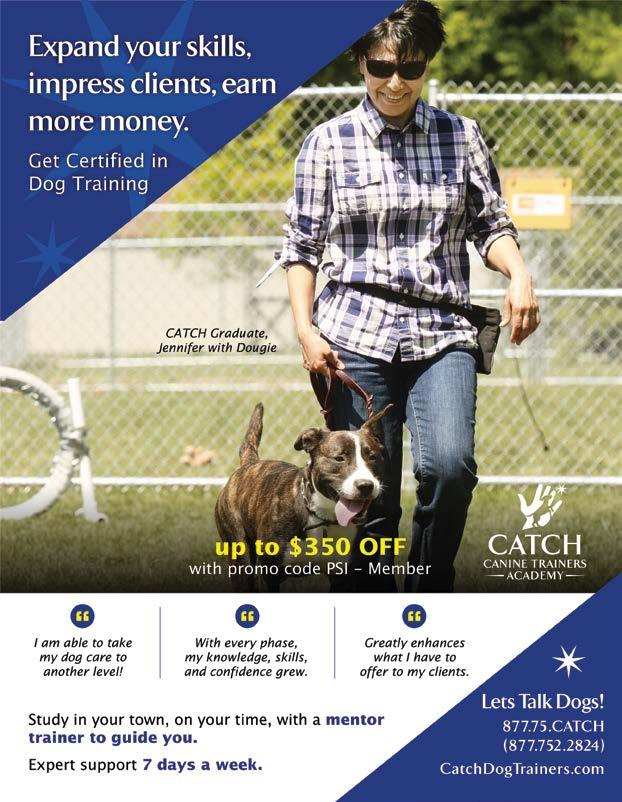
By Beth Stultz-Hairston, PSI President
While the spring season has, hopefully, brought welcomed sunshine where you are, in many areas the moderate springlike weather will soon turn to scorching temperatures. The summer brings unique seasonal challenges for pet sitters and dog walkers each year. This year, you’ll likely face other unique challenges as your business—if it’s like many we’ve heard from—is still navigating the best way to deal with such an increase in requests now that travel has returned to (or surpassed!) pre-pandemic levels.
So now is the time to start preparing to make sure you— and the pets in your care—remain healthy, happy and safe.



To help keep your cool this summer—and ensure you’re living your best #petsitterlife all year long—keep these tips in mind:
Avoid hot weather dangers. Whether you are spending time with pets outside or driving from assignment to assignment, you should take some steps to protect your skin from sunburn—and skin cancer.
Wear water-resistant sunscreen of SPF 15 or higher and keep it in your car or pet-sitter bag so you can reapply it every two hours. Wearing long-sleeved shirts and long pants, as well as a hat with at least a 3-inch brim and sunglasses, can also help protect your face and eyes. For more tips, visit www.skincancer.org.
Avoid walking dogs and playing outside with pets during the hottest hours of the day. Make sure your clients are aware of your policy (which protects you and their pets) and schedule your dog walks and visits accordingly.
It’s also important to know the signs of heat exhaustion. According to Mayo Clinic, possible heat exhaustion symptoms may include: “cool, moist skin with goose bumps when in the heat; heavy sweating; faintness; dizziness; fatigue; weak, rapid pulse; low blood pressure upon standing; muscle cramps; nausea; headache.” If you think you may be suffering from heat exhaustion, find a cool place, rest, and replenish fluids with water or sports drinks. (Pro tip: Keep a cooler with water and/or sports drinks in your vehicle if possible.).
Mayo Clinic also advises that you call a doctor if symptoms worsen or don’t improve within an hour and seek medical attention if your body temperature reaches 104 F (40 C). Learn more about heat exhaustion on the Mayo Clinic website
I’m fully BOOKed
Learn when (and how) to say, “I’m booked.” The summer vacation season is often a very busy time for both professional pet sitters and dog walkers. You may find that pet-sitting requests are pouring in and—if you are struggling to find enough staff sitters or if you have chosen to remain solo—it’s particular challenging to decide how to best handle so many requests! It’s important to recognize your limitations and know how many visits you can complete in a day without compromising the care you provide or jeopardizing your health or safety. When your schedule is overbooked and you are short on time, it’s much easier to make careless mistakes such as forgetting to lock the door behind you or leaving your keys in your car. You may also overlook red flags you would typically catch, such as a broken window or even misplaced items in a client’s home.
The best way to be able to say “no” (and to not feel as guilty about it) is to plan ahead—know when you are at capacity, then have a response ready. This way, you will not be caught off guard and will not feel pressure to simply give in and say “yes.” Be prepared with a list of other professional pet sitters and dog walkers you network with (and trust). This way, when a last-minute pet owner calls, you can have the confidence to say: “I would love to be able to care for Fluffy, but I cap my schedule at a certain number of visits to ensure all furry clients receive the absolute best possible care. However, I know a wonderful professional pet sitter who also services your area that I can refer you to this time, but I’m happy to take your information to put you on my email list and would love to pet sit for you in the future.”
Beware of break-ins. Many agencies report that break-ins (of both homes and automobiles) increase during the warmer months. As a pet sitter or dog walker, it’s important to be aware of your surroundings when you arrive to a client’s home. If an unexpected vehicle and/or person is in the client's driveway, do not stop. Contact the client to determine if he or she is expecting anyone to be at the home. If you cannot reach the client and/or the client did not expect anyone at the home, contact local law enforcement; do not return to the home until law enforcement arrives and determines the home is safe to enter.
If you arrive at a client's home and find open and/or broken windows or doors, do not enter the home. Immediately return to your vehicle, leave the premises, and notify the clients and local law enforcement. Again, while your first thought is likely to go in and check on the pet(s), do not return to the home until law enforcement arrives and allows you to enter.
You should also lock the doors of your vehicle before you enter a home for a visit. Then, once you enter the home, be sure to lock the doors behind you. This is easy to forget as your schedule is busy and your first thought is getting inside to visit the pet(s). However, locking both your vehicle and the home ensures that no one can follow you inside (or sneak in while you are busy caring for the pets) or access your vehicle while you are inside.
Keep your keys and phone with you at all times during the visit. This ensures a) that you cannot accidentally get locked out of a client's home and b) that you are able to have quick access to your phone in the event of an emergency.
Also, never keep in your vehicle any client information or forms with personal information that could put clients’ pets or homes in danger should your automobile be broken into.
Focus on your health. It’s easy to put yourself last—especially during the extra-busy summer months—but don’t make this mistake. We are all still dealing with trauma of the past three years, so it’s possible you still feel stressed and run down and self-care is more important than ever. Make time to eat healthy, get enough sleep and exercise. Many pet sitters find that preparing meals in advance—quick, balanced meals or smoothies they can bring along with them—is one of the best ways to avoid skipping meals or being tempted by the nearest drive thru.
Regular doctor visits also help you catch any potential medical issues or injuries early. Don’t ignore aches and pains that could indicate pulled muscles or other injuries that could prove debilitating if not addressed. Also, don’t skimp on buying quality shoes (your feet will thank you!) and remember to wear sunscreen.
In addition to your physical well-being, focus on your mental health as well. Burnout and compassion fatigue are very real issues in our industry—and, if left unaddressed, will begin to chip away at the professionalism of your business and the pet-sitting industry at large. If you are unsure
of what pet sitter burnout or pet sitter compassion fatigue are or how they are different, please be sure to read this previous post on The PSI Blog, “Pet Sitter Burnout and Compassion Fatigue— What you should know.”
If you have any health (physical or mental) concerns, be sure to contact your doctor. Just as we encourage pet owners to leave pet sitting to the professionals (like you), it’s important that you look to professionals for medical and/or mental-health advice.
Running a small business—particularly one in the pet-care services industry—seems to leave little time for much else, but it does not mean that you have to put yourself at the bottom of your to-do list.
In fact, moving yourself higher up on your list can help you offer better service to your clients and keep yourself safe. An overworked, overtired, and overcommitted pet sitter or dog walker is less alert, may not recognize red flags that could indicate danger and may make simple mistakes that put him or her in harm’s way. Practicing self-care is an important step to keeping yourself safe and business successful during the summer months and year-round!



from PSI Founder Patti J. Moran
When inquiring about a pet’s health and behavior history during an initial call from a potential client or at the meet and greet, I’m sure you are already asking the big questions—if the pet has a bite history, how they respond to strangers or other pets while on a walk, etc. We include these questions on the pet profile sheets available through PSI and also share specific questions you should always ask in this PSI blog post
This information helps you determine any special precautions you need to take on a visit, or if it’s an assignment you need to accept at all.
But I’ve found that pet sitters sometimes forget to ask these questions as they relate to multi-pet households. During the initial consultation, be sure to discuss with your client the nature of their pets’ relationships. Find out whether they have a history of aggressiveness or fighting between one another.
It’s a good idea to include this question in your service contract and note if arrangements to keep the dogs separated during feeding times or throughout the visits are necessary. Collecting this information—and then closely following any instructions the client provides— can help keep the pets in your care (and you!) safe throughout the assignment.
By Denise Fleck, The Pet Safety Crusader™
Effective restraint of the animals in our care is an important part of being a professional pet sitter. Whether you are merely transporting a dog or cat from one place to another or are in need of administering first aid to a sick or injured animal, there are three overarching rules to keep in mind:
1. Use the least amount of restraint and the least amount of people as possible. You’ve heard the adage, “Less is more,” and that can apply here as well. Adjust the amount of control you need according to the pet’s reaction and build as needed following the hierarchy below. Restrain for the behavior the pet is demonstrating, not for what you think he will do.
2. Invade the dog’s or cat’s personal space as little as possible. Make smart choices about your approach and follow through considering the pet’s point of view. Remain gentle and patient.
3. When working with a partner, always let the other person know if you are about to let go of the animal!
Animals have five reactions to stress: fight, flight, freeze, faint, or fidget. Fear, pain, and punishment can trigger aggression or fight behavior. The pet may scratch, bite, growl or hiss, fearing what you do may hurt more. He may dash off or take flight hoping to get away from the source of pain or to hide and lick his wounds. He may freeze in place before doing either of the previously mentioned behaviors or remain immobile but could turn aggressive if approached.

Certain species actually faint in the face of stress. Opossums and the Tennessee Fainting or Myotonic Goat are two examples. When caring for dogs and cats, it is unlikely you will deal with this behavior; however, the final response animals may exhibit is to fidget or become hyperactive. If prone to seizures, stress could trigger an episode
No response is an end-all as animals respond to our energy and actions. Paying attention to an animal’s body language may alert you to trouble before it occurs. Happy kitty can quickly become a sour puss when you trim her nails or insert a thermometer, so always consider your movements from the pet’s perspective. Towering over a pet can appear threatening while raising a hand over an animal’s head to stroke them could appear to the pet like a slap is coming.
Keep this hierarchy of restraint in mind:
1. Gentle voice and hands. Avoid screeching or sounding gruff. Rather, speak in a calm manner coaxing the pet to come or allow you to approach. Gently hold out your hands and provide treats.
2. Basic equipment. This may again consist of your gentle hands but also include towel, gloves, a leash, harness, and muzzle.
3. Confinement. Moving a pet into a small space like a bathroom provides more control of the situation, but confinement may also include a carrier or crate in which to transport or monitor a sick or injured pet.
4. Sedation. Medically calming a pet may be an option once you are at the veterinary clinic, but for dogs, canine-friendly aromotherapies may assist. Keep all essential oils away from cats!
Inhale deeply, then exhale slowly. Doing so will help you focus and remain calm. Although you want nothing more than to help, the pet may not understand your enthusiasm. Cats and dogs are experts at reading emotional cues, so do your best to minimize their anxiety. Watch body language for signs of pain or that the animal may lunge or bite. Flattened ears, yawning, lip licking, and heavy panting are common in fearful pets.
As mentioned above, use a calm voice and treats to lure the pet out from hiding. Position your body sideways to appear less threatening, and do not make direct eye contact. Do not approach if you hear growling.
If you have a barrier to protect yourself as you approach (a cushion for instance), get it slowly in front of you. A 6 ft. slip lead that can easily be made into a figure 8 harness is a useful tool. Place the handle through the “O” ring and drop the loop over the pet’s head. Next, bring the lead around the pet’s chest, behind his front legs and bring up the opposite side of the chest, again slipping the handle through the ring.
Small pets can be held secure by swaddling in a thick bath towel to control the head, cover the claws and prevent escape. Positioning a rolled towel under a dog’s lower jaw and wrapping the ends around his neck like a cervical collar is another option. You will still need to have a leash or other form of restraint to keep the body stationary. Doing the

best with what you have, where you are, is a first aider’s motto!

You can also make an impromptu muzzle out of any 1” wide soft fabric strip (e.g., leash, gauze roll, triangular bandage, legging, sash). Never use rope, string, cording, shoe laces, or narrow items that could cut the snout. A tube sock can also be improvised into a muzzle by cutting the foot portion lengthwise, slipping the calf portion over the dog’s muzzle and then tying the two ends you made by cutting behind the dog’s neck.
Don’t forget these important tips when muzzling an animal:
• Never leave a muzzled animal unattended—he is defenseless!
• If a muzzled animal experiences difficulty breathing, vomits or has a seizure, be prepared to remove muzzle.
If the pet you’re trying to help is a medium to large dog, and if he can get to his feet, placing a towel or even a grocery tote (split it up the sides so that it opens with a handle on each end) under the abdomen in front of the hind legs, can serve as a
back-end sling to assist walking.
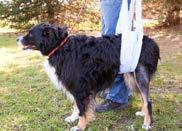
If the animal is immobile, a make-shift stretcher can be created by carefully sliding a towel or tarp underneath him. If you have a second pair of hands, lift the pet together by holding the towel taut to carry the pet to safety. If alone, slide a blanket gently under the pet, and on a smooth flat surface, pull one corner of the fabric carefully bringing the pet along with it.
Boards of all kinds can be used as backboards if you suspect back or neck injuries. Some car floor mats and SUV liners are quite sturdy. A storage box lid, cookie sheet, surfboard, or toboggan/ sled—even the pet’s bed or bottom of his crate—could do the job. Carefully secure the pet to the board before lifting, restraining him with torn sheet fabric, leash or other straps.
Do not attempt to carry an animal on any kind of improvised backboard device if the animal is struggling or resisting the restraint as this could cause additional injury.
Practice, training and thinking on your feet can assure you safely handle a sick or injured pet, prevent further injury, keep yourself safe and transport your furry patient to the care he needs.
Denise Fleck is the Pet Safety Crusader™, having taught 31,000 humans animal life-saving skills. Her mission is to help YOU make a difference in the life of an animal through her pet first-aid, senior pet care and disaster preparedness classes. Denise has appeared on television, radio and in magazines, and has authored more than a dozen books. She is the proud recipient of multiple awards from both the Cat and the Dog Writers Associations, including the PSI Professional Pet Care Award. Learn more at www.PetSafetyCrusader.com

By Kate Titus, A Loyal Companion
Science is so cool. I read an article recently about a study investigating self-awareness in dogs. In prior studies, dogs didn’t recognize their reflection in a mirror so were thought to have more limited self-awareness than humans. This conclusion was based on the assumption that dogs were as vison-driven as we are. (Hint: They’re not. Scent and sound, anyone?)
The current study found that a dog’s self-perception is more rooted in his body position. The dogs in this study were asked to bring a toy to the handler. At a designated point in the exercise, the toy was attached to a mat the dog was sitting on. Therefore, to move the toy, the dog had to first move himself, thereby demonstrating he recognized that his body was the obstacle that kept him from moving the toy. In other words, he was aware of his body and the consequence of his actions in moving his body.
As my evolutionary biologist friend (everyone should have a scientist friend!) pointed out, there would be no evolutionary benefit to a dog for recognizing himself in the reflection of a stream or a mirror. His benefit comes from recognizing the barriers–or opportunities–of his body in the environment around him. Think about a dog carefully and quietly placing a paw on the earth as she stalks his prey or how she uses their body protect or warm pups.
That got me thinking about the proprioception and body awareness exercises I do with mobility-challenged dogs in the A Loyal Companion gym. While my focus and end game is always helping the dog move through their world as easily and comfortably as possible, I’m also working to build and maintain the dog’s awareness of self within his environment. The results of the current study gave me another perspective on why dogs use their bodies in the ways they do.
This article also brought back a memory of my dog Harley and his tail Harley was a Great Dane/foxhound mix with a barrel chest, stilt-like legs and long, ropey tail. In the last year of his life, he would sometimes get his tail wrapped under his lanky legs. When he’d try to stand up, that tail would be caught under one of his rear paws and his butt would stop rising abruptly and he’d plop back down in a heap. After the failed attempt, he’d recognize the problem and move his paw away from his tail and start the lifting process all over again.
I’m fascinated by watching dogs navigate their worlds, whether it’s through rolling hills and trees, over the sidewalks of the city, or across the kitchen floor. They have a lot to teach me, and I can’t wait to learn!

Kate Titus founded A Loyal Companion in 2008 to provide massage, exercise, and mobility solutions for senior dogs. In 2015, she opened the first canine fitness and mobility facility in Arizona, featuring an indoor swimming pool and complete dog gym. Since then, more than 3,000 dogs and their pet parents have come through the doors in Tucson. Kate is also the author of two books on canine mobility, Sit. Stand. GO! How to help your dog overcome mobility challenges and Emotion to Motion: How the mind impacts your dog’s mobility, published by Dudley Court Press. Her website also features a Canine Mobility Resource Center





According to PSI’s most recent surveys, couples with children—on average—make up about 37% of members’ client bases.
If you are looking to grow your company’s client base, this is a client segment you’ll want to reach. As a PSI member, you have access to PSI’s Early Educational Program materials in the Members Area of petsit.com. We’ve had these program resources available to members for several years as we’ve been keeping an eye on this client demographic of clients with children—so if this is not a segment of pet parents that you have really focused on marketing to before, our Early Education materials will be an easy way to just dip your toes in the water of reaching out to potential clients with both fourand two-legged children.
As a business owner, you probably look for ways to give back to your community, as well as ways to raise awareness about your pet-sitting business. Using PSI’s Early Education Program materials you can do just that, while promoting responsible pet ownership (and the idea of professional pet sitting as a career) to local children through school programs and other outreach efforts.
In the Early Education Program section of the PSI website, you can download these materials:
• Customizable coloring and activity book
• Creating a butterfly garden information sheet
• Pollination activity sheet
• Pollination word search
Each download can be edited to add your business name and contact information before printing.
But once you’ve printed the materials, how do you get them in the hands of children? This is an important step! By introducing your business to children and providing them with educational information, you can also reach their parents, as most kids will take the materials home with them.
Consider these ideas to distribute the materials:
Volunteer to be a guest reader at a school. Many elementary schools look for volunteer readers throughout the year, and in the U.S., Read Across America Day in March is a great opportunity to offer to volunteer. When I’m a guest reader at a school, I always bring some of the Early Education Program coloring pages to pass out to the children after I read a pet-related book. Don’t forget to add your business contact information to the coloring sheets!
Participate in a school’s career day. School career days give you an opportunity to share the Early Education materials and to also educate kids about your job and explain how pet sitters help pets (and their people). If you aren’t sure if your local schools host career days, reach out to the school’s guidance counselor to find out and offer to be a resource. Some schools host in-person career days/ fairs and some use Zoom or similar platforms.



Keep kids in mind when you have booth space at events. When you participate in events, have a booth that attracts children. Have your customized coloring and activity sheets prominently displayed on your table to attract families with kids. I’ve also found that a DIY photo booth is a big draw for families with children. Set up a simple backdrop and petrelated photo props (think dog and cat masks or ears, etc.). You can take photos with your cellphone, provide your business card and let the families know that you’ll upload the event photos to your company’s Facebook or Instagram.
Donate coloring sheets (and crayons) to local restaurants. This is a great way to reach families with children, and to also partner with another local business and build your relationships in the community. While chain restaurants likely already have coloring sheets (or branded materials to give to children), locally owned restaurants likely don’t. You can donate coloring sheets and crayons that they can provide to patrons with children who dine in (or include them with takeout orders that include kid’s meals).
PSI member Jill Merjeski, owner of Jill’s Next Door Dog Walking & Pet Services, LLC, in Highland Beach, Florida, shared this about how she included PSI’s Early Education materials in her recent community outreach efforts:
We presented at Emerging Minds Montessori Academy in Delray Beach, Florida, on March 29, 2023. It was a wild success teaching students aged 3-13 the importance of pet safety and animal rescue! We had interactive demonstrations on pet care as a career, bite prevention, how to approach an unfamiliar dog, and how they can get involved with helping animals that need homes. All of the 111 students adopted a stuffed dog or cat complete with their own kennel and a certificate honoring their pet safety completion and being an animal rescue hero.


Have you participated in the PSI Early Education Program? Contact us to share photos and details on your participation. —Beth Stultz-Hairston, PSI

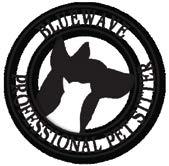
For over sixteen years, Bluewave Professional Pet Sitter has enabled professional pet sitters and dog walkers to streamline their office tasks so that they can better serve their clients, grow their businesses, and save time for other professional and personal endeavors.
• Pet Information – Detailed information concerning each pet, including veterinarian, pet routines, diet, behavior & physical characteristics, etc.
• Pet Owner Access Component – Customers can request services and follow-up on service status, utilizing your company website.
• Service scheduling – quickly schedule services involving multiple staff / multiple services with minimal effort. Service confirmations / re-confirmations can be sent when appropriate.
• Targeted Client Communication/Promotions
– Utilizing client groups, promotions can be targeted to specific clients.
• Staff Vacation/Time-off tracking
– Integrated into the scheduling process, it simplifies scheduling jobs, eliminating the opportunity to schedule staff that have requested/approved time off.
Let our proven, high-performance application be your path to success! Our friendly, knowledgeable, US-based support team is available to get you up & running quickly.
• Individual Client Pricing – Each customer has pricing-specific to their needs and services requested. Prices can be adjusted individually or as part of a group.
• Advanced Compensation Option – calculates staff compensation based on a) client, b) service, and/ or c) staff assigned. The system can calculate compensation using the most granular rule identified.
• Client profile data – Only staff responsible for the client or staff assigned to a service have access to the client profile data.
• Accounts Receivable – Quickly post payments from customers, transfer payments to multiple service orders easily. Flexibility to collect payments on your schedule.
• Reporting – Owners/Admins have access to a robust suite of historical & financial reports that can be retrieved for any desired timeframe – daily, weekly, monthly, quarterly, or annually.
• Work whenever & wherever Our users can connect securely and effortlessly to our web-based platform from any Internet/ Wifi enabled device.
• Nothing to Install or Update
• Time Management Thoughtful design means less time at the computer, allowing for more time and freedom to do what’s important to you, like hiring & training staff and spending time with family.

Using industry-standard software and state-of-the-art hardware, your data is continually backed up & available when you need it.
By Savanna Westwood, CPPS®, The Savvy Sitter
Dogs experience the world through their sense of smell first and then vision. Hearing is a dog’s next strongest sense and by stimulating a dog’s auditory senses with music, we can greatly enhance the quality of life for our pets. Music can be helpful in reducing anxiety, assist with blocking unexpected environmental sounds (sirens, thunder, fireworks, etc.), calm hyperactive behavior, and help dogs relax and sleep.
Music, especially music with repeated sounds, causes a dog’s brain to send messages that relate to relaxation, referred to as sonic mantras. These music sounds influence the dog’s brain and emotional reactions, inducing relaxation and a hypnosis type state.
Music can help both puppies and adult dogs, and especially anxious dogs, dogs with separation anxiety, and dogs that are fearful of noises. Even without those issues, music can simply enhance a dog’s sleep or nap. When you play music while your dog is resting it will become what they associate with good, relaxing moods.
If you repeat the same music over and over, it can sometimes become annoying to your dog after about seven days. Try swapping out the music you’re playing for them on a daily basis to keep their mood consistent and steady throughout the day.
Soft, classical music has been shown to be one of the best sources of musical stimuli to help soothe or calm dogs. Similarly, New Age, Soundscapes, Smooth Jazz, and Reggae can also be effective music styles.
There are some dogs who aren’t exactly the best at containing their emotions when they’re left alone and are lonely. Many owners have a sad tale or two about what happened while their pup was left at home.
Choosing the right mu sic can keep your pet calm and collected while you are away and can reduce heart rate, blood pressure and cortisol levels of your uneasy dog that is home alone.
During Thunderstorms or Holidays involving Fire works
There is a particular phobia in dogs called storm phobia. This phobia comes from sensory stimulation, such as thunderclaps, lightning, and even changes in barometric pres sure. Fireworks can similarly mimic the same flashes of light and sound as thunder and lightning. You will know quickly if your dog suffers from storm phobia. A quick and easy way to help dogs overcome storm phobia is to play calming music for them when a storm hits. The truth is that the upset caused by environmental sounds can be improved in the dog’s life by incorporating natural sounds into their lifestyles with music, which can also support any behavioral issues.


Some satellite and cable companies have a variety of different types of music channels and stations. Smart Home devices such as Google and Alexa can play music on a voice command. Finally, YouTube channels, such as Peaceful Pet Music, offer music with and without nature sounds and small visual animations to help enrich your dog’s life, especially while no one is home.
By stimulating a dog’s auditory senses with music, we can greatly enhance the quality of life for our pets and make their lives calmer and happier!
Savanna Westwood is the owner and founder of The Savvy Sitter, Pet Sitting and Dog Walking, LLC, in Winter Garden, FL. She earned her CPPS-Certified Professional Pet Sitter® designation in 2020. She is a lifelong animal lover and an active equestrian. Her newest passion project relates to the power of music and pets, particularly on how to keep them calm and entertained while their parents or sitters are away. Visit her YouTube Channel, Peaceful Pet Music—Tranquil Tunes for Peaceful Pets, here.
By Rachel Doran, Tell Your Tails
Organic vs. paid social-media marketing: what’s the big difference? Should you be budgeting for paid social-media marketing in your pet-sitting business? We’ve got the full scoop on the difference between organic and paid and how to choose. Plus, how you can integrate the two!
What is Organic Social-Media Marketing?
Organic social-media marketing refers to posts that are posted without any payment. If you’re currently using social media for your pet business, this is likely what you’re already doing. Any free content that you post— whether posts, Stories, videos, etc.—is considered organic.
So, who sees these organic posts? Well, firstly, your followers, or more accurately, a percentage of your followers, are shown these posts. This is called your “organic reach.” At first, your post is shown to a chunk of your followers, and if it performs well, the social-media algorithm will often show it to a wider net of your followers.
These organic posts can also be seen through any of the hashtags you use. Anyone following a hashtag or searching for a hashtag you use may possibly see your post.
So, what does this all mean? What are the results or effects you can expect to see from organic social-media marketing? Organic social-media marketing is incredibly important. It is the backbone to your social-media marketing, and without it, your paid marketing wouldn’t have anything to stand on.
At organic marketing’s core, it is all about building your brand, increasing brand awareness, and nurturing your customers. This means, your primary focus should be on your existing followers. Your existing followers are likely a good amount of current customers plus some potential customers interested in learning more about your services.
Tailor your organic content to your existing followers! Think:
• “What do my customers need to see to…learn more about our brand and what we stand for?”
• “What do my customers need to see to…feel safe and comfortable using our services?”
• “What do my customers need to see to…refer other customers our way?”
This doesn’t mean that organic social-media marketing can’t get you new followers. Through post sharing, hashtag usage, and just the way the algorithm works, there are opportunities to show up on the feeds of people who don’t follow you. But, keep in mind, those opportunities are slim in comparison to how many followers’ feeds you’ll show up on.
So, again, focus on your existing followers. If you provide them with information and a brand to really rally behind, new followers will flow in naturally.
P.S. If follower count is your primary goal right now, we suggest taking a look at this helpful blog post, Setting social-media goals for your pet-sitting business, to help you reconsider and reframe your goals!
What is Paid Social-Media Marketing?
Think of paid social-media marketing as today’s advertising. Gone (well, mostly) are the days of TV or radio commercials. Instead, socialmedia posts are advertised to users when they’re scrolling through an app.
Paid social-media posts are exactly what they sound like. You pay for them to be posted, and in turn, the posts are shown to a larger, and more targeted, audience.
So, unlike organic social-media marketing, the goal of paid social-media marketing is to grow your audience and get new eyes on your content.
Paid social-media posts can do a wonderful job of bringing in new potential customers, but of course, they come at a price

5 hours of video training


(literally). This means that most brands can’t exist solely with paid social-media marketing. Instead, a combination of organic and paid is what you’ll most commonly see.
Should You Use Organic or Paid?
First and foremost, do what you think is best for your unique pet-sitting business. Consider your goals.
Are you trying to grow your business and get new clients? Consider paid posts.
Or are you trying to keep things low-stress and easy with your current client load? Organic may be the place to be.
P.S. Keep in mind that, as business owners, we get that we always want growth in some form. Having a waitlist of clients is certainly a nice, comforting
feeling. But if your money, time, and resources are better spent on things like…growing your team or improving your existing service offerings, skip the paid posts for now. You can always start to add paid posts once you’re in a position to take on new clients.
• Organic posts are for your existing followers.

• Paid posts are for getting new followers.
Many businesses only use organic social-media marketing. And that is totally okay!
But, if you’re interested in paid social-media marketing, and want to make sure you’ve got a good strategy in place, read this full article on the PSI Blog that shares some tips to keep in mind
Rachel Doran, owner and founder of Tell Your Tails, specializes in helping passionate petpreneurs build marketing strategies that are sustainable, profitable, and uniquely YOU. Through coaching and tailored social media, email, and blogging services and resources, she helps you tell your own unique tale to captivate your pet business upper fans! Learn more at tellyourtails.com
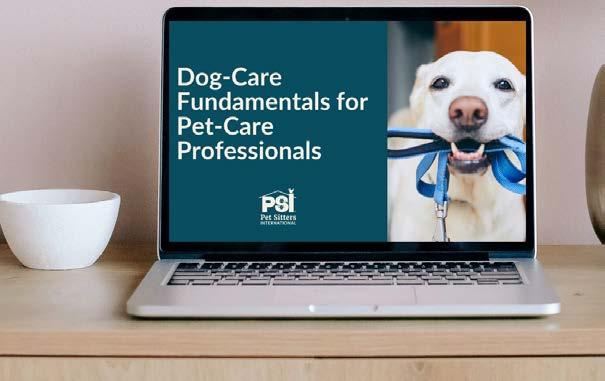
Are you taking advantage of your PSI Monthly Member Toolkit?

Each month you receive your Monthly Member Toolkit, which includes:
• Your Monthly Scoop email with trending articles you can share with clients
• A featured online article with bonus resource/special offer just for members
• A featured member resource—often a pet-sitter form template, client handout or webinar
• A monthly Facebook Live in PSI’s private, members-only Facebook group
Resources are emailed to you each Monday at the email address associated with your membership.
If you are not receiving PSI’s weekly emails, please contact PSI Member Services at info@petsit.com.

Looking for an affordable, easy-to-access continuing-education solution for you or your staff?
Now choose from two PETSIT PRO subscription options:
Pet Sitter Plan for one user/individual
Business Plan for pet business owner + unlimited staff
PETSIT PRO subscribers can access:
• A new mini course each month, led by an industry expert
• A Pet Care Resource Library with 80+ training videos
• A Business Resource Library with nearly 50 training videos*
Visit petsit.com/online-courses and use coupon code WORLD5 to save $5 off the monthly subscription fee. Offer ends June 15, 2023.
*Business library not included with staff log-ins


You know you wouldn’t steal from your clients, but being bonded can give them extra peace of mind and boost your business.

Contact Business Insurers of the Carolinas to learn how you can obtain a dishonesty bond for only $50/year. www.psi-ins.com